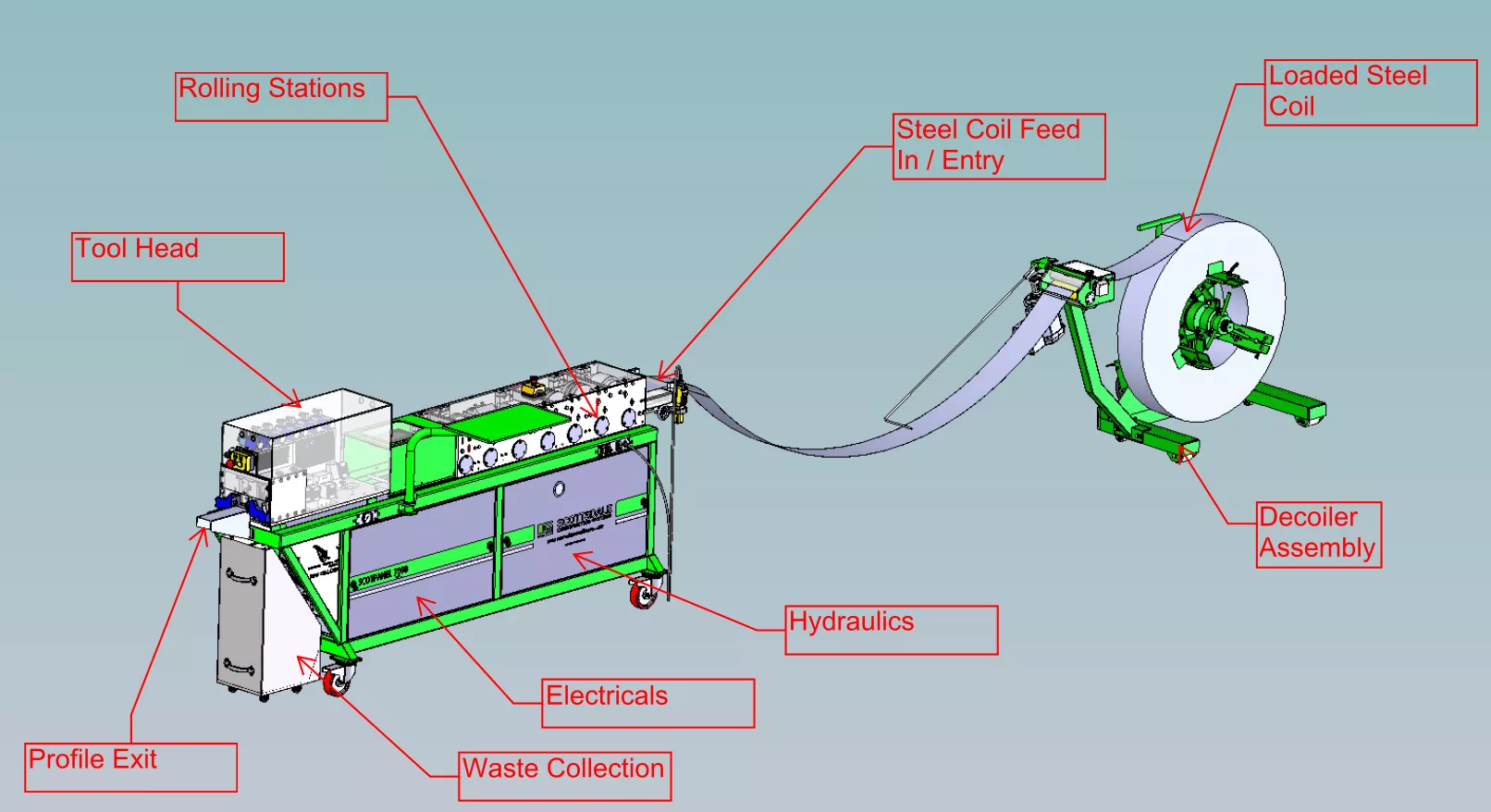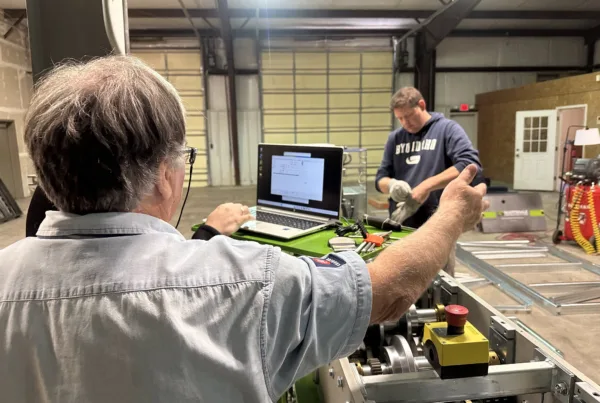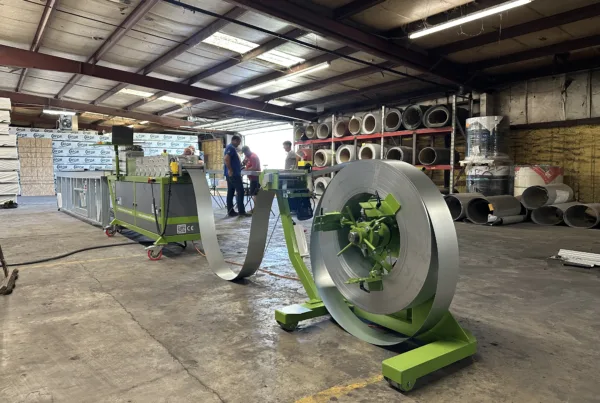Roll forming is a highly efficient and precise metal forming process used to create consistent, complex profiles from long strips of sheet metal. By feeding metal coils through a roll forming machine equipped with a series of rollers, the material is gradually shaped into its final profile—without the need for heat.
This continuous bending method allows for tight tolerances, high-speed production, and minimal material waste.
Today, roll forming plays a critical role across a wide range of industries—from automotive and aerospace to commercial construction and residential framing.
The rise of cold-formed steel framing has been especially transformative in the construction world, enabling faster builds, stronger structures, and more cost-effective framing systems. Builders and manufacturers alike rely on roll forming to streamline production, reduce labor costs, and deliver precision-engineered components at scale.
In this article, we’ll explore what roll forming is, how the process works, and why Scottsdale’s advanced roll forming machines, including the Knudson by Scottsdale lineup, are trusted by leading fabricators around the world.
What is Roll Forming?
At its core, roll forming is a cold bending process used to produce uniform metal components in high volumes. Unlike stamping or press braking, which deform metal with forceful strikes, roll forming uses gradual, successive bends across multiple roller stations to achieve the desired shape. This method is ideal for producing long, linear components like steel studs, tracks, channels, and custom profiles.
Because roll forming is continuous, it offers unmatched efficiency for high-volume production runs. Once a metal coil is loaded into the system, it can be uncoiled, flattened, punched, formed, and cut to length—all in one seamless operation.
How the Roll Forming Process Works
The roll forming process begins with feeding a metal coil into a roll former. The material passes through a decoiler and straightener before entering a series of precision rollers. Each roller set makes a small, controlled bend to the strip until the full profile is formed.
Along the way, additional operations like pre-punching, notching, or embossing may be integrated, depending on the final application.
This modular design allows roll forming machines to handle a wide variety of materials, thicknesses, and profile designs—with minimal setup time and high repeatability.
Scottsdale’s Integrated Roll Forming Workflow
At Scottsdale, every step, from material feed to finished product, is engineered for efficiency, precision, and automation:
Decoiler & In‑feed Control: Scottsdale roll formers handle universal coil sizes (up to 3300 lb / 6500 lb decoilers) with guided in‑feed systems that center the coil, reduce stress on rollers, and allow quick gauge changes during production.
Multi‑stage Roller Stations: Systems like Scotpanel (63–140 mm depth, 0.69–1.2 mm thickness), Scottruss, and the KFS Framemaker and the KFD Framemaker use 7–13 roller stations to gradually form profiles. This ensures smoother finishes, tighter tolerances, and less roll wear.
In-line Punches, Notches & Dimpling: Heavy-duty structural and light-gauge machines include hydraulic punch and shear tools for holes, dimples, service cutouts, and end-bearing features—integrated into the profile with no extra handling.
Smart Servo Drives & Guillotine Cut: High-capacity models like the KFS Framemaker reach speeds up to 2,200 m/hr, using digital batch controllers for precise length control. The Scotpanel and Scottruss lines use end-bearing guillotines for cleaner cuts and stronger end-studs.
Seamless Software Integration: Scottsdale’s ScotRF production software links CAD or BIM design files directly to the roll former. Knudson KFS/KFD machines are compatible with Vertex BD, Strucsoft MWF, and Framebuilder, enabling a streamlined design-to-production pipeline.
The Benefits of Roll Forming Over Other Metal Forming Methods
Roll forming offers several compelling advantages when compared to traditional metal forming processes like extrusion, press braking, and stamping. Here’s a closer look at what sets it apart:
- Efficient High-Volume Production
Roll forming is renowned for its capacity to produce large quantities efficiently. This makes it ideal for industries needing consistent and rapid output without sacrificing quality. - Precision and Consistency
The process ensures exceptional precision, achieving tight tolerances and uniformity across all parts. The outcome is components with superior surface finishes, ready for immediate use or minimal post-processing. - Enhanced Flexibility
Unlike press braking or extrusion, roll forming is inherently more adaptable. It can easily accommodate a wide range of metals, each with different surface coatings, flexibilities, and dimensions, making it a versatile solution for diverse applications. - Durability with High-Strength Materials
Roll forming excels in processing high-strength steels without causing breakage or tears. This ability opens up possibilities for crafting components that are both robust and reliable. - Lightweight and Strong Designs
By using less material, roll forming can create components that are stronger yet lighter. This efficiency not only reduces material costs but also enhances performance, particularly in the automotive and aerospace sectors.
Roll forming stands out for its efficiency, precision, and adaptability, proving to be a superior choice for industries focusing on high-quality, durable, and lightweight metal components.
Key Processes in Roll Forming
The key processes in roll forming are summarized below. Each plays a critical role in shaping, customizing, or finishing the metal profile as it moves through the machine.
- Rolling: The core process of roll forming—metal is gradually shaped by a series of roller stations that apply controlled bends to form the final cross-section without cracking or deforming the material.
- Cutting: The continuous metal strip is sheared to custom lengths using integrated guillotine or flying cut-off systems. This allows precise part sizing without interrupting the production flow.
- Notching: Specific areas of the profile are cut out (or “notched”) to accommodate joints, service penetrations, or connections—critical in framing applications for electrical or plumbing access.
- Punching: Predefined holes or slots are added to the profile for structural fasteners, service cutouts, or assembly requirements. Punching is typically automated and driven by the CAD model.
- Swaging: This involves reducing or offsetting the profile at certain points for easier joining of components—commonly used in truss construction or telescoping assemblies.
- Flattening: The edges or flanges of a profile may be flattened to improve fit, reduce sharpness, or prepare the part for fastening or additional forming steps.
- Dimpling: Small indentations are pressed into the steel to create recesses for screw heads or structural reinforcement. Dimpling improves both aesthetics and fastening precision.
Each of these operations is performed by dedicated toolsets within the roll forming machine and can be fully automated depending on your configuration.
Inside the Roll Forming Process: Components, Capabilities & Customization
Scottsdale’s advanced roll forming systems integrate every stage of the metal forming process into a seamless, automated workflow—allowing fabricators to produce complex, precision-cut components in a single pass.
Below, we take a closer look at how each part of the machine contributes to its performance and how material choices and secondary operations influence output quality and flexibility.
Rolling: The Foundation of Roll Forming
The rolling process is the foundation of roll forming, which is a continuous process used to create long metal shapes with specific cross-sectional profiles. This process involves the gradual deformation of metal sheets or strips through a series of precisely engineered rollers. Unlike press braking or stamping, this method allows for smooth, continuous forming with minimal stress on the material.
A roll forming system includes several key components that contribute to this efficiency:
- Rolling Stations: Precisely spaced rollers gradually form the desired shape with consistent force and alignment.
- Decoiler: Feeds metal coil into the system while minimizing stress and misalignment.
- Hydraulics: Power essential forming and punching operations throughout the machine.
- Electricals: Regulate timing, motor speeds, and process synchronization.
- Software: Converts CAD or framing designs into machine instructions for automated production.
- Tool Head: Houses the custom die sets, punches, or shear systems needed for each project.
An overview of various components of a roll former is presented in image below.
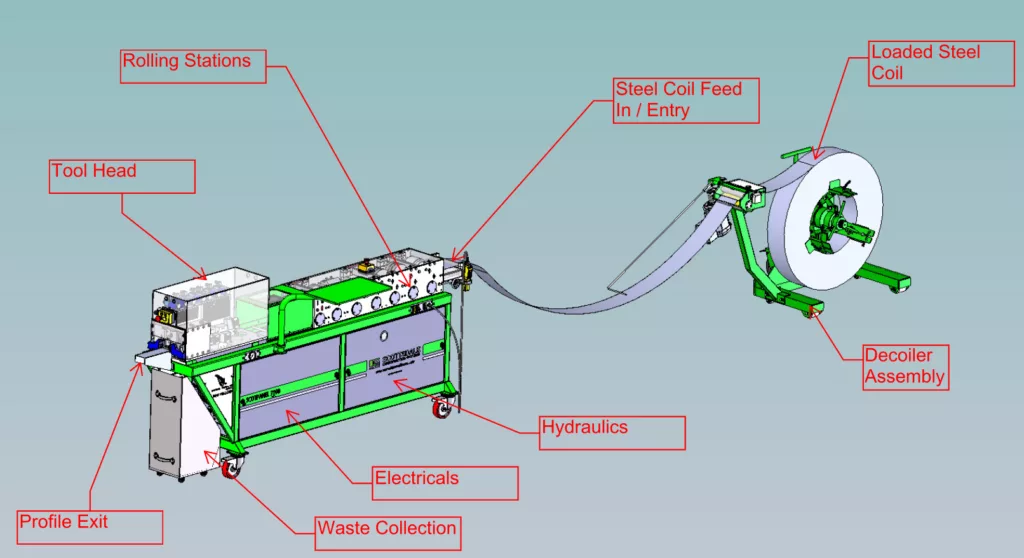
Material Gauge Ranges in Roll Forming
Roll forming is renowned for its versatility, particularly when it comes to the variety of material gauges it can handle. Typically, roll forming mills are equipped to work with materials ranging from 0.010 inches to 0.250 inches in thickness. This broad range enables industries to utilize roll forming for both thin and thick materials, accommodating diverse project needs.
Bend Capabilities & Material Ductility
The bend capabilities in roll forming are highly influenced by the ductility of the metal being used. Metals that exhibit good ductility can be shaped more easily, allowing for tighter bends. In fact, achieving 180-degree bends is quite feasible when using suitable materials. This flexibility makes roll forming an excellent choice for creating complex shapes and components.
Secondary Operations Integration
One of the standout features of roll forming is its ability to integrate secondary operations seamlessly. Processes such as welding, punching, and precision laser cutting can be incorporated into the overall production workflow. This integration not only enhances production efficiency but also contributes to the creation of more refined and finished products.
In summary, roll forming is a powerful metalworking process that accommodates a wide range of material thicknesses and allows for intricate bending, with added efficiency from integrated operations.
Key Components of a Roll Former Machine
To fully understand how roll forming delivers such precise and efficient results, it’s important to look at the core components that drive the process. Each element within a roll forming system—mechanical, hydraulic, electrical, and digital—plays a critical role in shaping metal profiles with speed and accuracy.
At Scottsdale, our machines are built with a deep focus on integration: seamlessly combining powerful hardware with intelligent software to execute complex operations in a single pass. From the initial decoiling of steel to the final punched and cut profile, each component below contributes to the reliability, flexibility, and performance that Scottsdale roll formers are known for.
Let’s take a closer look at the essential building blocks of a modern roll former:
Rolling stations
The number of rolling stations determines the type of profile that gets produced by a roll former. Rolling stations help in forming various bends within the roll former and also in producing the stiffeners along the profile web. During this stage, the metal strip is fed through a series of rollers that gradually shape it into the desired profile. The rollers are strategically designed and spaced based on the principles of roll forming to ensure precision and consistency while optimizing the production output. A typical roll cage is shown in the images below.
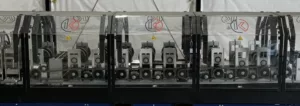
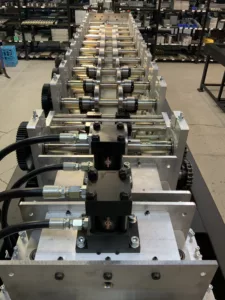
Decoiler
The automatic decoiler stores and unrolls the steel coils into the roll formers in a seamless manner without the need for manual interventions, thereby helping in achieving a constant input of steel into the roll formers for production. Scottsdale and Knudson by Scottsdale have decoilers with their respective capacity varying from 1500 kg to 4500 kg. Customers have the option of choosing from a variety of decoilers based on their usage and needs.
Hydraulics
Hydraulics are an essential component of the roll-forming process. Operations such as cutting, notching, and punching are powered by the hydraulic unit within the roll former. The speed, efficiency, and precision of these operations rely heavily on the performance of the hydraulic system. A typical hydraulic pump and motor setup within the Scottsdale roll former is shown below.
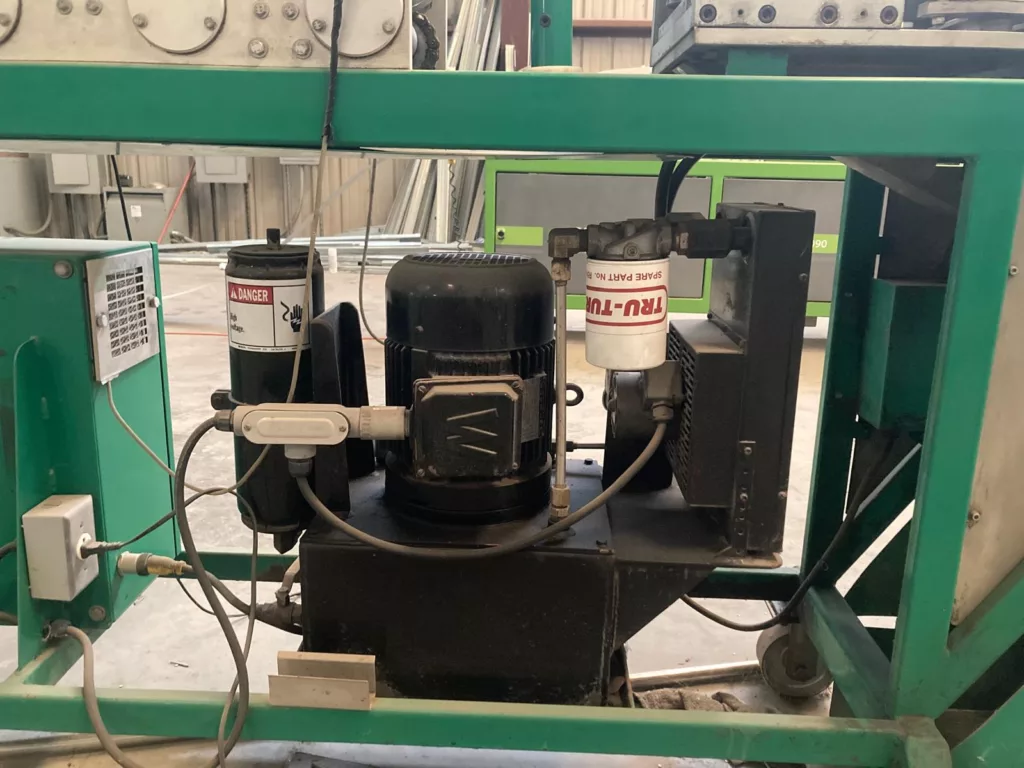
Hydraulics in roll forming are typically integrated with electrical systems and controlled by bespoke software packages, enabling automation of essential operations such as cutting, notching, and punching. These advanced software systems provide precise control, enhancing efficiency, repeatability, and overall productivity in manufacturing processes. However, there are situations where these operations can also be executed manually, offering flexibility and adaptability when automation is not feasible or necessary.
Scottsdale stands out in this field by excelling in both the design and manufacture of high-performance roll formers and the development of state-of-the-art software packages. These integrated solutions ensure seamless automation and exceptional functionality, delivering superior outcomes in roll-forming applications.
To further enhance the roll forming process, a wide array of additional solutions and technologies are seamlessly integrated, providing comprehensive support and versatility:
- Mandrel, Roll, and Stretch Bending: Enhance the shaping precision of materials.
- Tube Fabrication and CNC Tube Bending: Offer advanced customization for tubular components.
- Laser Technologies: Including tube laser cutting, 5-axis laser cutting, and laser welding, ensuring precision and efficiency.
- Cutting and Piercing Solutions: Miter cutting, off-line piercing, and CNC cut-to-length for tailored results.
- Welding Options: Robotic, in-line, and laser welding for robust and precise assembly.
- Advanced Machining and Contouring: Delivering intricate designs and detailed finishes.
- Assembly and Kitting Services: Streamlining production with efficient organization.
- Variable Gauge Forming: Taper and roll reduction for dynamic material handling.
- Heat Treatments and Coating Services: Solution heat treatment, artificial aging, powder-coating, and E-coating, enhancing durability and appearance.
- Post-Dip Galvanizing and Tailored Profiles: Offering protection and custom solutions for specific applications.
- Laser Cut Bend Relief: Ensures structural integrity in complex designs.
These complementary technologies work in tandem to elevate the roll forming process, ensuring that every project benefits from precision, efficiency, and innovation.
Electricals
Electrical systems are the nerves of any roll former, acting as the communication and control hub that ensures the smooth operation of the entire machine. Just as nerves transmit impulses for the human body to perform its functions, a robust electrical system is essential for coordinating the various components of a roll former.
These systems manage motor drives, sensors, PLCs (Programmable Logic Controllers), and safety devices, ensuring synchronization, precision, and safety during operation. A well-designed electrical system minimizes downtime, enhances productivity, and provides adaptability for different production requirements.
The electrical cabinet, typically housing these critical components, exemplifies the intricate control network necessary for seamless roll-forming performance. A typical electrical cabinet within the roll former is shown below.
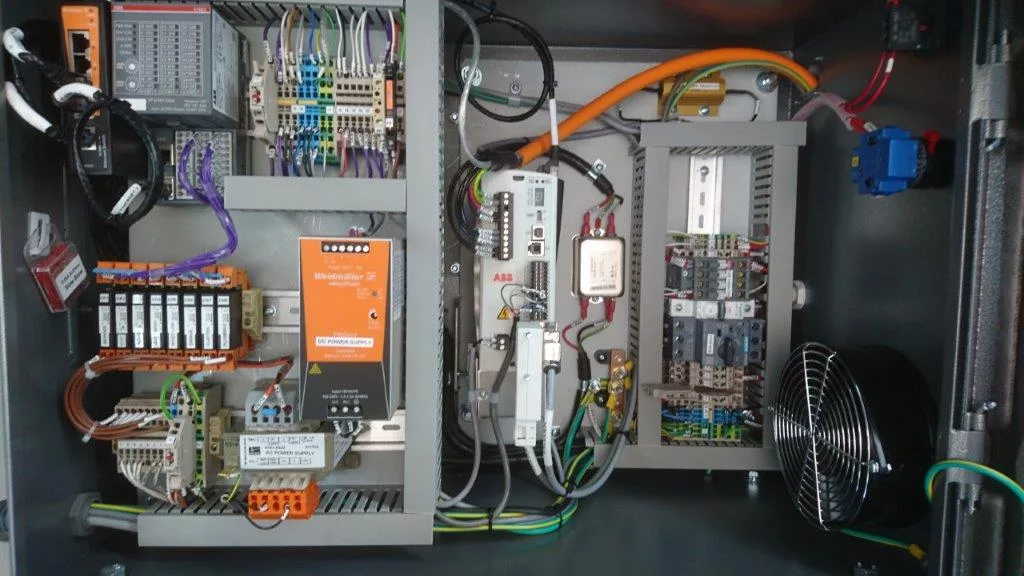
Software
Bespoke software packages are needed to automate the roll-forming operations. This includes cutting the profile to length, punching holes at specified locations, making dimples at specified angles for connecting members, notching members for intersecting connections, swaging the ends to make a bearing connection etc.
These intelligent operations at predetermined locations are cumbersome to perform manually in a roll former, and henceforth, software packages play a crucial role in communicating these operations to the roll former.
The integration of software and hardware is key to achieving optimal performance of the roll formers without slowing down the production process. The software must communicate effectively with the electrical systems within the roll formers, thereby establishing a seamless connection and coordination during the roll forming process.
Scottsdale produces bespoke software called ScotRF to communicate with the roll formers. Support for other third-party software packages, such as MWF Pro Metal plugin for Autodesk Revit and Vertex BD are also facilitated within the ecosystem.
Learn more about Scottsdale’s roll forming machine workflow and software integration.
Learn more about Scottsdale’s ecosystem.
Learn more about ScotRF software and capabilities.
Tool Heads
Multiple tool head options are available within the Scottsdale product lineup and are discussed in detail in their respective sections. Tools heads that are available within the Scottsdale and Knudson by Scottsdale series of roll formers include the following:
- Cutting
- Notching
- Punching
- Swaging
- Flattening
- Dimpling
- Coping
Cutting
Cutting is a critical process in roll forming, where the formed profile is precisely cut to the required lengths to meet specific design and structural needs. This operation is typically performed using a guillotine positioned at the exit stage of the roll former. The intelligent ScotRF software enhances this process by enabling the roll formers to cut profiles accurately to the required dimensions, facilitating the production of various structural elements such as studs for wall panels, and components like top and bottom chords, webs, and other elements for cold-formed steel trusses.
In the world of roll-formed steel, a vast array of components can be created to suit diverse architectural and structural applications. Some examples of these components include:
- C Purlin: Essential for supporting roof loads and wall cladding.
- Z Purlin: Known for its strength and versatility in roofing and walling structures.
- Custom Purlins: Tailored to meet specific design specifications.
- Z Sections: Used for their lightweight yet sturdy properties.
- Angles: Integral in frameworks and bracing applications.
- Tubular Forms: Including rectangle, square, and round tubes, each offering unique benefits for structural integrity.
- Specialty Tubes: Such as Peanut Tubes and Lock Seam Tubes, designed for specific industrial needs.
- Channels and Rails: From C Channels to Omega Rails, perfect for creating robust frameworks.
- Custom Profiles and Shapes: Allowing for innovative and unique design solutions.
These components highlight the adaptability and precision of roll forming technology, showcasing its capability to manufacture both standard and custom elements efficiently. This extensive variety ensures that roll-formed steel can meet the intricate demands of modern construction and engineering projects.
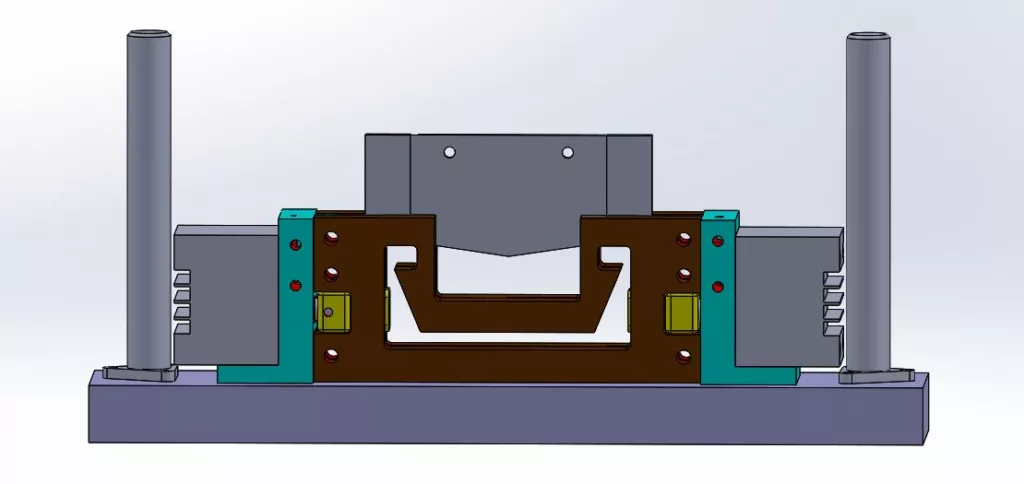
Notching
Notching is a vital process in roll forming that involves creating precisely positioned slots, holes, or indentations in the material to enhance its functionality and usability. This step is essential for enabling the assembly or integration of the formed profiles with other structural components. Depending on the design and manufacturing requirements, notching can be performed either before the rolling process begins or after the profile has been formed. Notches are commonly introduced to allow a main member to pass through or to facilitate connections within a structural assembly. These features play a critical role in ensuring secure and efficient construction. Typical examples include creating a notch in a stud to allow for a connection to a continuous nogging or forming a T-intersection in the truss top chord for a heel connection. These applications underscore the importance of precision and accuracy in the notching process. The image below illustrates a notch on a C-section web, highlighting its functional design and application in structural assemblies.
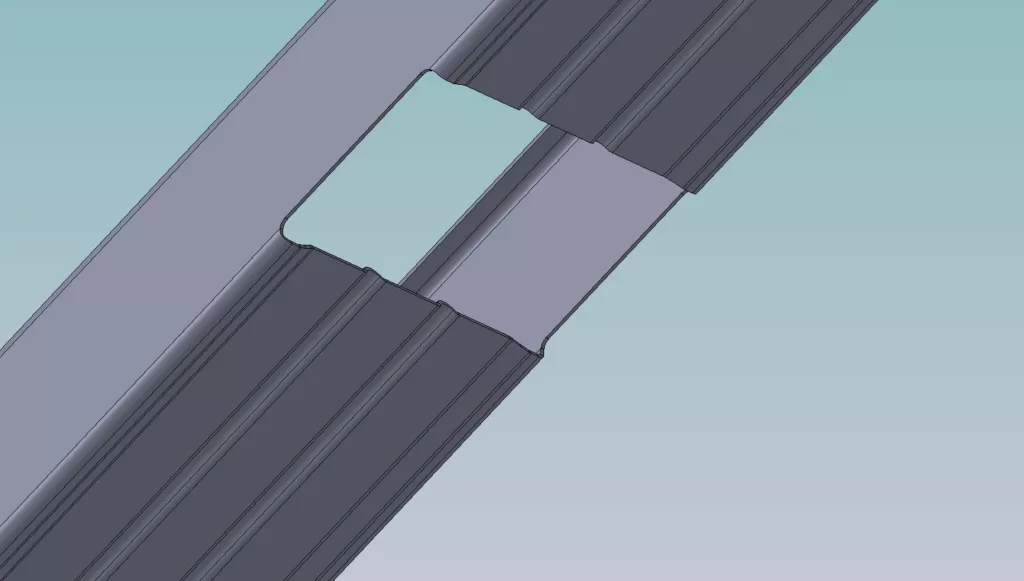
Punching
Punching involves creating holes or slots in the material using a die and a counter punch. This process is essential for adding features like bolt holes, plumbing, and service holes. Punches are often made on the flanges and webs of the section and can vary in size and shape. Various punches and use cases are discussed below.
The image below shows bolt and rivet hole punches made on the webs and flanges of the Hat and C-section, respectively.
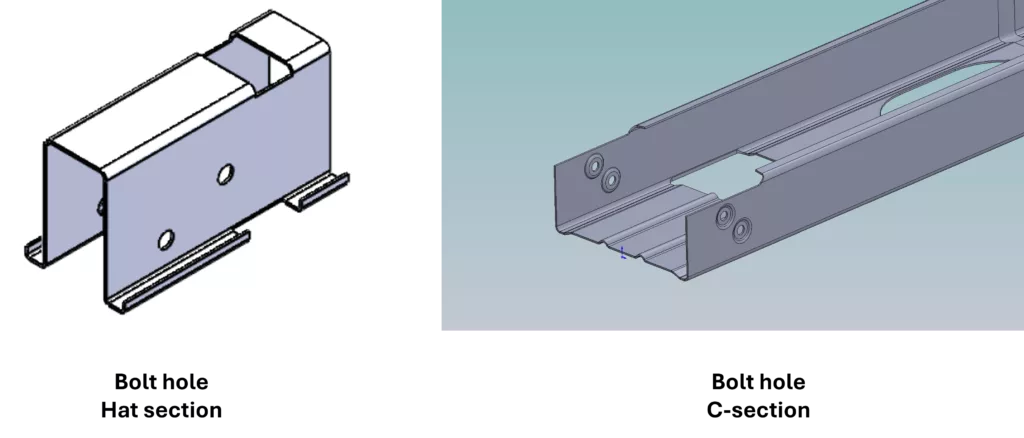
Holes made on the flanges are generally slots are cuts to accommodate various secondary members. Slots are punched on the top plate of the wall to stud connection, allowing for the vertical movement in buildings. The slots can be single or multiple in nature. Flange cuts, on the other hand, are not common but are used in rare cases to accommodate end/intersection connections in C-section. The image below shows slots and flange cuts in the C-section profile. These slots are generally made in the flat state of the coil before the rolling process.
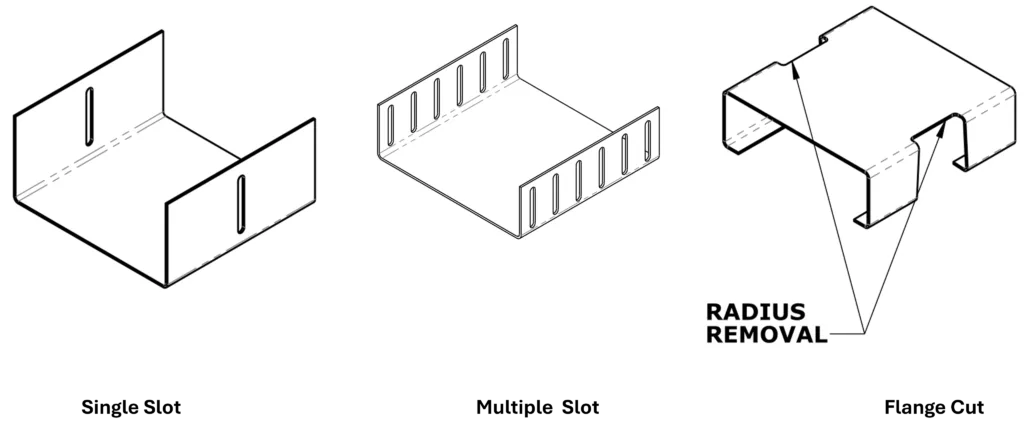
Punches are also made on the profile webs in various shapes and sizes. This includes slots and tabs. The image below shows some of the commonly used slots and tabs.
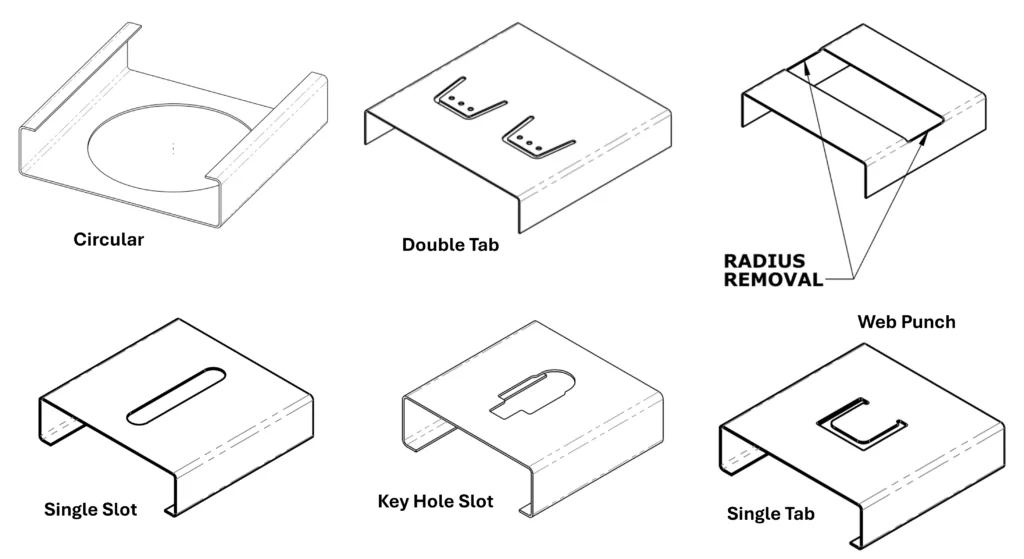
An overview of the applications of some of the punches is detailed below.
- Circular punches are used for service holes and HVAC ducts in the web of the C-section. These holes vary in size depending on the application.
- Single slot holes on the webs also vary in size and depth and are often used as plumbing holes and slotted screw holes on the top track of non-load bearing walls to accommodate in plane movements in buildings.
- Key slot holes are predominantly used for proprietary clipped noggings to provide in-plane buckling resistance of C-section members.
- Single and Multiple tabs are often used in C-section bearers to connect the joists, thereby forming floors.
Swaging
Swaging is a process that crushes the profile, thereby reducing the width of the profile. It is achieved by applying compressive forces through rollers or dies.
Swaging is done on profiles to get a closer fit in the connection to enhance the load transfer between structural elements, thereby achieving better connection capacities. In some cases, swages are used in the end of the wall studs to form end bearing connections wherein the connection capacity is overridden by the bearing capacity of the stud. This is particularly useful in designs with higher axial load demands, thereby reducing the dependency on the structural adequacy of the connections, which are generally less than the bearing capacity of the profile. The image below shows commonly made swages within the C-section webs at the middle and end of the member.
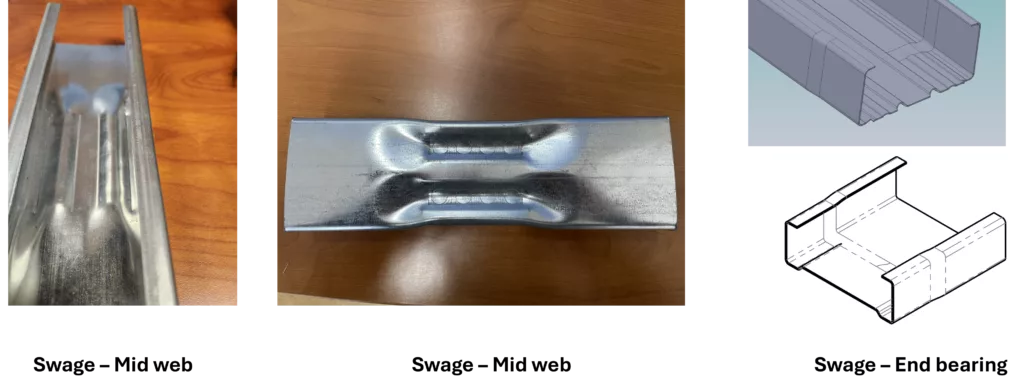
Flattening
Flattening is used predominantly in C-sections to flatten the formed lips of the profile. This ensures a T-intersection connection is made with another C-section. The flattening tool can also be used to form an unlipped C-section, which can also be used as a U-track or Top plate on walls. The image below shows a continuous flattening operation within the Scotpanel roll former.
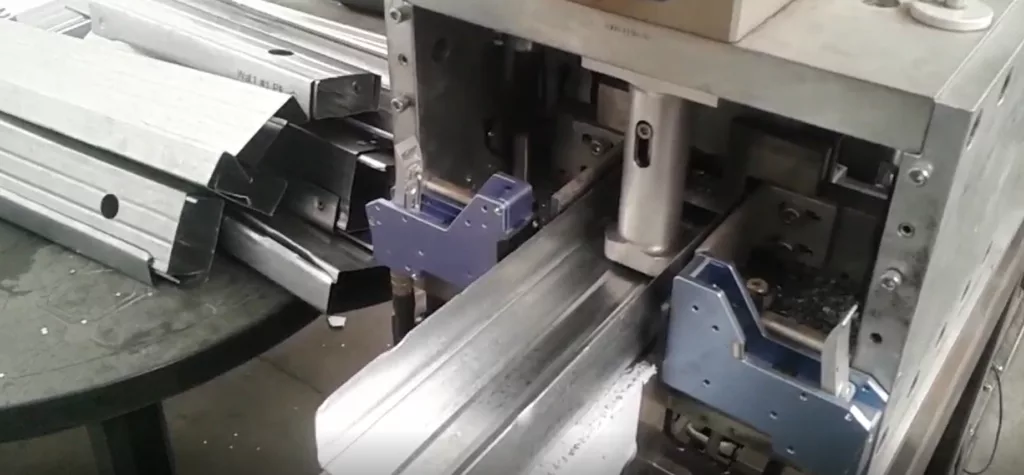
Dimpling
Dimpling involves creating small indentations or depressions in the material. This process is often used around the connection holes such as rivet/screw holes. Dimples in the connection allow for the connector to stay in place during shear action, thereby reducing connection slip, which can inherently reduce the connection capacity. Dimples are also helpful in reducing the protrusion of the connector such as screws and rivets within a wall panel thereby reducing the bulge in the cladding. This helps in achieving a much cleaner and smoother finish and avoids the risk of cracks due to bulging. The image below shows dimples on a double rivet C-section profile.
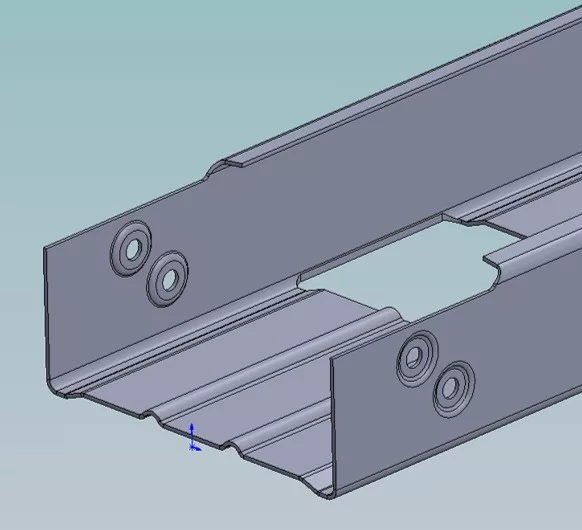
Coping
Coping is the process of removing the lips within a profile. These can be of varying lengths and angles depending on the application. Copes in C-sections are generally used to connect perpendicular members. This is an alternative to flattening as discussed in previous sections. Angled copes are often used in the web members of C-section trusses oriented about the major principal axis. The image below shows various coping options for C-section profile lips.
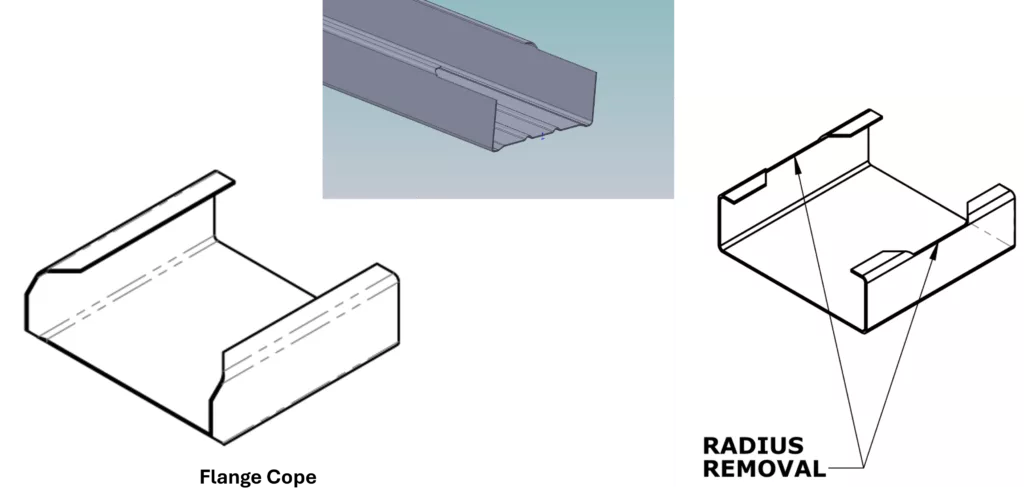
How Does Roll Forming Compare to Other Metal Forming Processes?
When evaluating roll forming alongside other metal forming techniques like extrusion, press braking, and stamping, there are several compelling aspects where roll forming stands out:
- Volume and Efficiency
Roll forming is an ideal choice for high-volume production. Its continuous nature allows it to efficiently create large quantities of metal components without frequent pauses or adjustments. - Precision and Consistency
This process excels in producing parts with tight tolerances and uniformity, ensuring that each piece meets rigorous specifications. The superior surface finish achieved during roll forming often eliminates the need for additional finishing processes. - Flexibility and Adaptability
Roll forming can accommodate a variety of metals, even those with unique surface coatings or differing flexibilities and dimensions. This adaptability provides a considerable edge over processes like press braking. - Material Strength and Integrity
Unlike some methods that may struggle with higher-strength steels, roll forming processes can form these materials with ease, avoiding issues like breaking or tearing. It also allows for creating stronger, lighter components with less material, optimizing both performance and cost. - Complex Geometries
Roll forming’s ability to craft complex shapes and sections surpasses many other methods, like stamping, which can be limited by die costs and production run sizes.
In contrast, methods such as extrusion may face limitations with larger cross-sections, while stamping can be constrained by die wear and tear during high-volume production. Press braking, although precise, might not match the consistent speed and flexibility offered by roll forming.
To delve deeper into the comparative advantages of roll forming over these techniques, explore additional resources and industry insights to fully understand its transformative impact on metal manufacturing.
Key Advantages of a High-Efficiency Flexible Roll Mill
Switching from a traditional roll line to a high-efficiency flexible roll mill offers several significant benefits that can revolutionize your manufacturing process:
1. Customizable Dimensions
- Versatile Adjustability: Unlike conventional systems, a flexible roll mill allows for seamless width and height adjustments. This versatility means you can tailor your equipment to meet specific production requirements without needing multiple setups.
2. Streamlined Setup Process
- Reduced Setup Time: One of the primary advantages is the dramatic reduction in setup time. By simplifying the configuration process, you can prepare for production much faster, optimizing operational efficiency and minimizing downtime.
3. Precision and Efficiency
- CNC Punching Capabilities: These machines often come equipped with CNC punching features, ensuring precise and accurate shaping and cutting. This added precision reduces errors and enhances the overall quality of your products.
4. Cost and Time Savings
- Lower Tool Lead Times and Costs: Another critical factor is the reduction in both tool lead times and costs. By decreasing the dependency on custom tools, you can save valuable time and resources, allowing for a more agile production line.
Transitioning to a high-efficiency flexible roll mill can lead to a more adaptable, precise, and cost-effective production process. Whether you’re looking to boost productivity or improve quality, these advantages make a compelling case for the upgrade.
Materials Used in the Roll Forming Process
Roll forming is a versatile method of shaping metals, allowing for the transformation of various materials into precisely detailed profiles. Here’s a look at some of the materials commonly used in this process:
- Steel Variants:
- Cold-Rolled Steel: Known for its excellent surface finish and tight tolerances, it’s ideal for precision applications.
- Hot-Rolled, Pickled, and Oiled Steel: Offers a cleaner surface post-milling, suitable for a variety of structural uses.
- Pre-Painted Steel: Already coated, it reduces the need for post-production painting.
- Galvanized Steel: Features a zinc coating for enhanced corrosion resistance, making it perfect for outdoor use.
- Stainless Steel: Renowned for its strength and resistance to rust, it’s a top choice for durable applications.
- High-Strength Low Alloy (HSLA) Steel: Combines strength and formability, used often in automotive sectors.
- Ultra-High Strength Steel (UHSS): Ideal for applications demanding maximum strength.
- Aluminum: Lightweight and corrosion-resistant, aluminum is prized for its ease of use in many commercial applications.
- Copper, Brass, and Bronze: These materials are valued for their aesthetic appearance and resistance to corrosion, commonly used in decorative as well as functional applications.
- Titanium Alloys: Known for their strength-to-weight ratio, these are used extensively in aerospace and high-performance industries.
- Specialty Alloys:
- Inconel®: Perfect for high-temperature environments due to its heat resistance.
- Hastelloy®: Offers outstanding corrosion resistance, ideal for chemical processing industries.
- Martensitic Grades: These steels are particularly hardened for enhanced wear resistance.
- Dual Phase Steels: Known for their unique balance of strength and ductility.
- TRIP Steel: Utilizes transformation-induced plasticity, beneficial in highly demanding automotive sectors.
Through the roll forming process, these materials can be precisely shaped and adapted to meet the diverse needs of industries across the board, from construction to automotive and consumer goods. This versatility is what makes roll forming a preferred method in modern manufacturing.
Roll Forming Automation: Efficiency Meets Innovation
Scottsdale Construction Systems integrates advanced roll-forming processes into cohesive, automated solutions that redefine modern construction. Our cutting-edge roll formers are designed to deliver unparalleled precision, speed, and versatility, enabling the rapid production of steel components that consistently meet the most stringent quality standards.
Scottsdale’s dedication to innovation ensures our systems not only streamline manufacturing processes but also support sustainable practices by minimizing material waste and optimizing energy consumption.
With a wide range of customizable options, our roll formers are capable of producing optimized cold-formed steel sections tailored to meet diverse project needs. Whether it’s for residential housing, commercial developments, or industrial structures, Scottsdale’s roll-forming technology offers exceptional efficiency, customization, and cost-effectiveness. Our solutions empower construction professionals to bring their designs to life with unmatched accuracy and reliability.
As the trusted steel framing partner for construction professionals worldwide, Scottsdale is committed to delivering systems that consistently exceed expectations. By choosing Scottsdale, you’re investing in proven solutions, cutting-edge technology, and a partner dedicated to building stronger, smarter, and more sustainable structures for the future.
